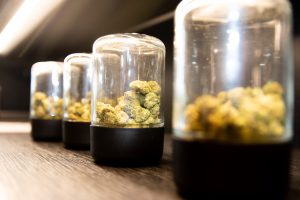- Slug: Sports-NCAA Athletes Cannabis, 760 words.
- File photo available. (thumbnail, caption below)
By Jonah Krell
Cronkite News
PHOENIX – After taking gradual steps over the last two years, the NCAA is on the cusp of sweeping changes to its policies on cannabis use by its athletes, including removing it from a list of banned substances.
In a session at the NCAA Convention Thursday, a group of panelists discussed the recent cannabinoid policy updates and the work that remains to incorporate these changes on campus.
The three panelists are all members of the Committee on Competitive Safeguards and Medical Aspects of Sports (CSMAS), which recommended in September 2023 that each NCAA division introduce and adopt legislation to remove cannabinoids — the chemicals found in the cannabis plant — from the association’s banned list.
The basis for the recommendation stems from the December 2022 Summit on Cannabinoids in College Athletics, which featured “the consensus opinion that cannabis is not a performance-enhancing drug and that a harm reduction approach to cannabis is best implemented at the school level,” the NCAA posted in a June release.
“One of the things we know about college students specifically is that treatment and education strategies work better than penalties,” said CSMAS member Nadine Mastroleo, an associate professor in the department of psychology and faculty athletics representative at New York’s Binghamton University. “The last piece of this is really testing within a campus or at the local level. That is the best approach to using and finding individuals who actually might have a problem and could really use some support to reduce their use and to recover from whatever problems they may be having from that.”
Mastroleo says this focus on the individual athlete is a significant shift from the former policy, where athletes were subject to testing during postseason play and could lose a season of eligibility for one failed test. In February 2022, CSMAS recognized the need for change, increasing the THC testing threshold from 35 to 150 nanograms per milliliter and proposing a new penalty structure (that all three divisions eventually passed) that incorporated treatment and education plans.
These recent revisions are meant to help athletes using cannabis at a problematic level rather than catching them for making one mistake. The policy updates also come as cannabis use continues to become more socially accepted nationwide. Thirty-eight states have legalized marijuana for medical use and 24 for recreational use. According to a 2023 NCAA Student-Athlete Health and Wellness Study, 43% of college athletes are using marijuana in states where it is legal for recreational and medical use.
Just like multiple other professional leagues already, the NCAA is now adapting to the times.
“Harm-reduction interventions, meaning meeting individuals where they are, are likely to be more effective in reducing cannabis-related health consequences than abstinence-only approaches,” said CSMAS member Deena Casiero, the senior associate athletics director for sports medicine and the head team physician at the University of Connecticut. “We know that randomly testing small groups of individuals at championships is not likely going to be as effective a deterrent as educating athletes about what this substance is actually doing to their bodies.
“How is this affecting your injury risk? How is this affecting your recovery? How is this affecting your performance? How is it affecting your sleep, your mental health? Pushing those agendas are going to be way more effective than randomly testing a group of individuals and then punishing them when they test positive.”
Since the CSMAS recommendation in September, the committee has been focused on developing education and communication strategies that schools can use to implement on campus.
At the session, Lagwyn Durden, the director of sports medicine at the NCAA Sport Science Institute, shared that Division I schools introduced the CSMAS proposal to remove cannabis from the banned substance list at their January meeting and can vote on it in June.
If passed, the ruling would be effective for the new academic year in August. Durden said that it might take longer to pass legislation in Division II and Division III due to the time it takes to move through their individual legislative processes.
“So for those of you that will be getting emails from your student-athletes’ parents, we will hopefully be offering the information to you to help with that conversation,” Mastroleo said to the audience in regards to public concerns about CSMAS’ recommendation. “What we’re going to create ideally will be a really good toolkit of opportunities to really help with dispelling myths and also letting them know that we are out there for the athletes.
“Will we help everybody walk away from it? No, but I mean, how many of us can actually make everybody happy?”
